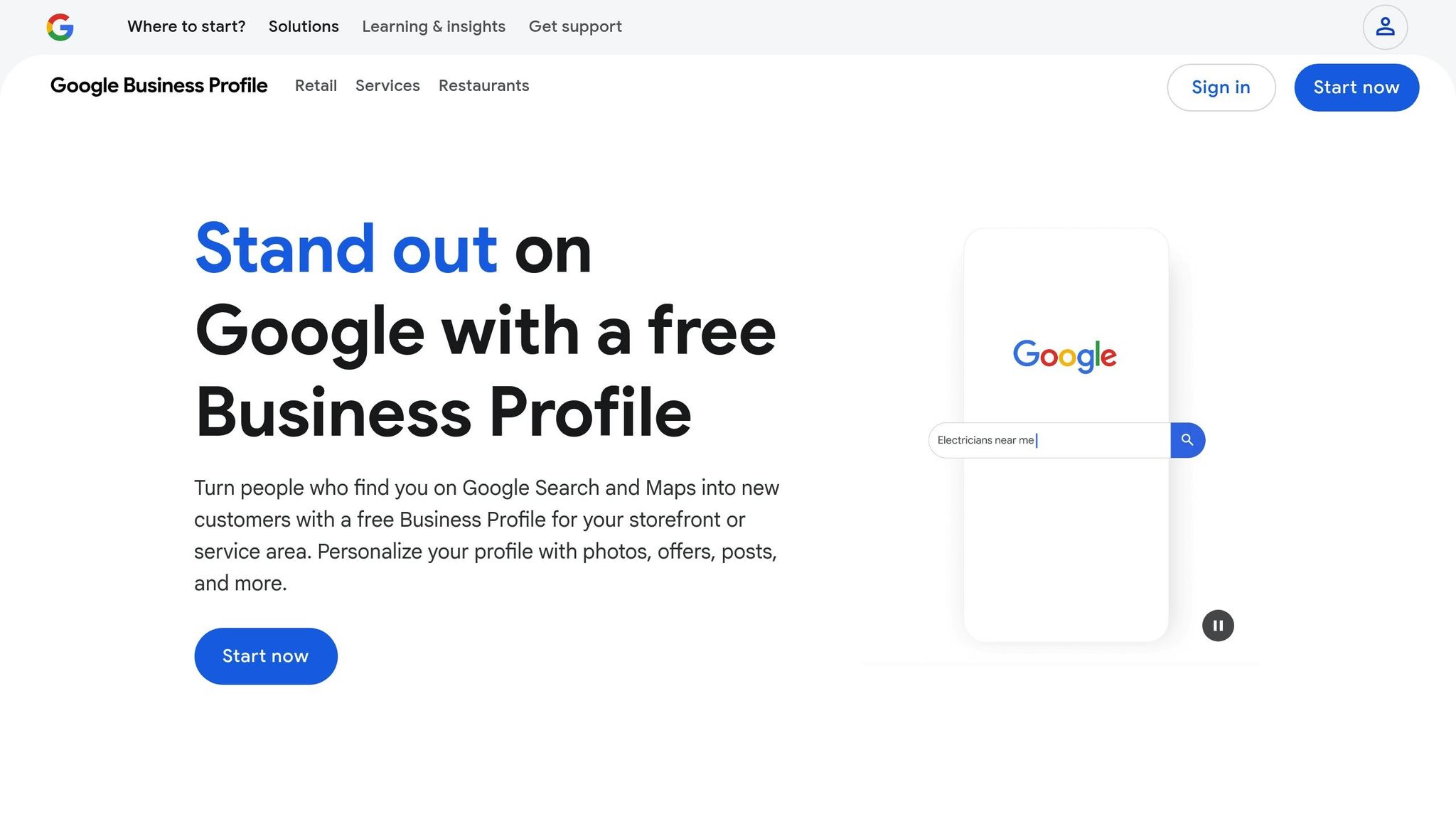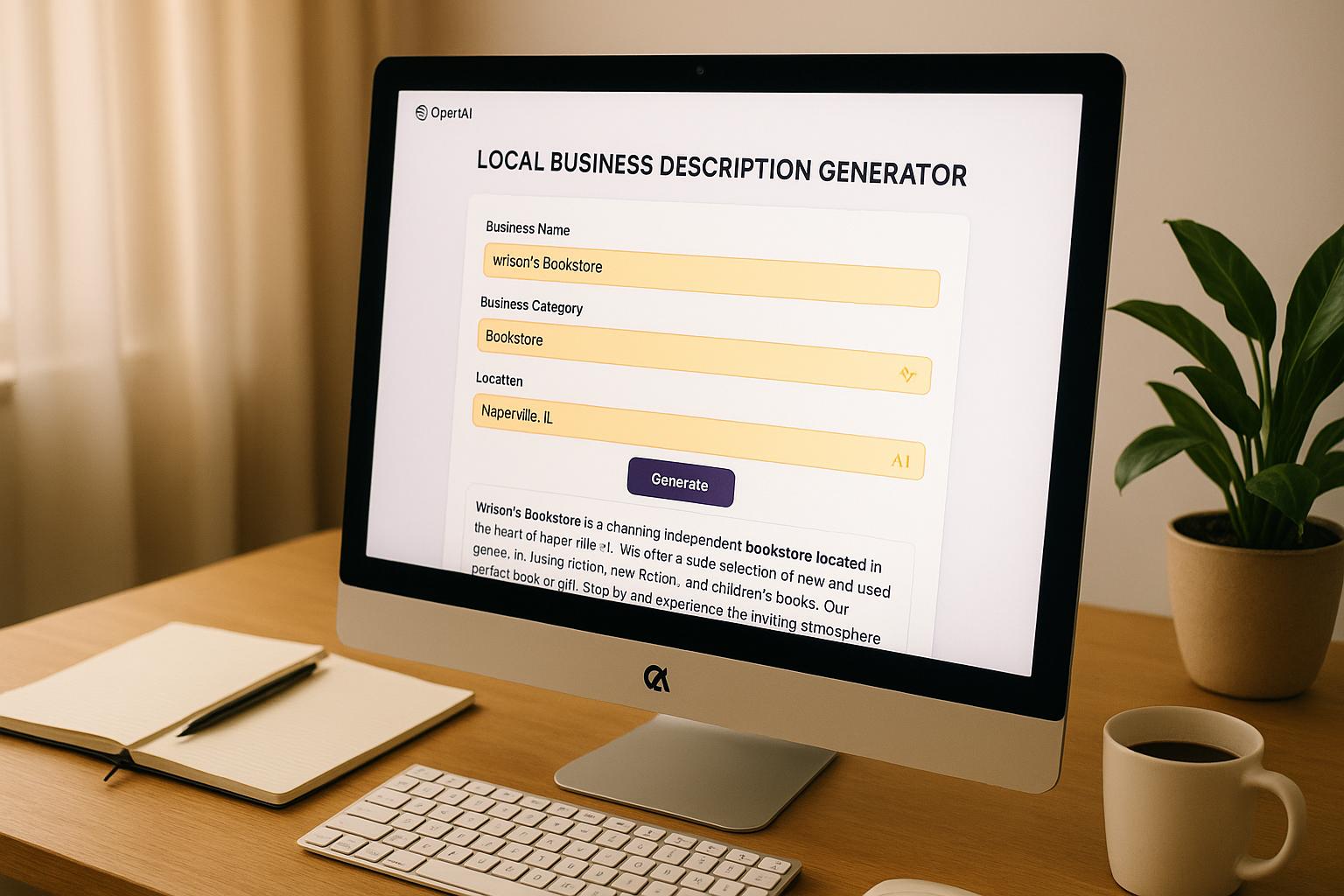Mobile local landing pages are your business’s digital front door for nearby customers. With mobile searches dominating local intent queries like "pizza near me", your page needs to load fast, provide key details instantly, and guide users toward action.
Key Takeaways:
- Speed matters: Mobile users expect pages to load in under 2.5 seconds. A slow page drives them away.
- Key info upfront: Display business hours, location, contact details, and services clearly.
- Voice and map optimization: Optimize for conversational queries and map-based searches.
- Trust indicators: Include reviews, certifications, and real photos to build confidence.
- Call-to-action buttons: Use clear, tappable buttons like "Call Now" or "Get Directions."
Google’s mobile-first indexing rewards pages that are fast and user-friendly, so focusing on these elements boosts both rankings and conversions. Whether users are multitasking or searching urgently, your page must deliver the right info quickly and effectively.
The Exact Steps My Agency Uses To Create City Service Pages For Small Business Local SEO
How Mobile Users Search for Local Businesses
Mobile search has become all about speed and relevance. People want instant answers, especially when looking for local businesses. To meet these needs, businesses must create landing pages that align with modern search habits. This includes optimizing for voice and map-based queries, as well as catering to quick decision-making on mobile devices.
Voice Search and Map-Based Queries
Voice search has completely reshaped how people find local businesses. Instead of typing something like "Italian restaurant downtown", users now ask, "Where can I get the best Italian food near me?" These conversational queries require businesses to optimize for natural, everyday language rather than relying on rigid keyword structures.
Map-based searches are another major factor in local discovery. When someone opens Google Maps and searches for "coffee shop", they’re looking for details like location, distance, hours, and ratings - all at a glance. This means your business information needs to be clear, concise, and easy to scan. If users can’t find what they need quickly, they’ll move on to another option.
The combination of voice assistants and mapping services has created an even more seamless experience. For example, someone might ask Siri for directions to a nearby hardware store or look for a 24-hour pharmacy. These searches often happen in real-time, where users need fast, actionable results.
Location-based triggers also play a big role. When users enter a specific area, their phones often suggest nearby businesses through notifications or search prompts. This means your landing page might be someone’s first impression of your business. If it doesn’t deliver the right information immediately, you could lose them to a competitor.
By optimizing for these search behaviors, you can ensure your business shows up when and where users need it most.
Quick Decision-Making on Mobile
Mobile users don’t have the luxury of time - they need answers fast, and their decision-making reflects that urgency.
People searching on mobile are often multitasking, whether they’re walking, commuting, or juggling other tasks. Your landing page only has a few seconds to grab their attention and communicate value before they move on to the next option.
What do users prioritize? First, they look for credibility - things like clear contact details, business hours, and customer reviews. Then, they want easy access to actions like calling, booking, or getting directions. These micro-moments - like searching for "urgent care near me" - are high-stakes situations where users need specific information immediately, such as insurance details or wait times. If your page makes them dig for answers, they’ll likely leave.
Mobile users also make snap judgments based on how your page looks and performs. A cluttered design or slow-loading page doesn’t just frustrate users - it pushes them straight to competitors with smoother, faster experiences.
Another challenge is context switching. Mobile users often jump between tasks - starting a search, replying to a text, checking social media, and then returning to their search. Your landing page needs to make it easy for them to pick up where they left off and move toward conversion without confusion.
Finally, trust is critical on mobile. With less screen space to work with, users rely on trust indicators like professional photos, recent reviews, clear contact information, and visible business credentials. These elements help users feel confident in their choice, even when they’re making decisions quickly.
Core Elements of High-Converting Mobile Local Landing Pages
A successful mobile local landing page strikes the perfect balance between technical efficiency and a user-friendly design. These pages not only look great but also function seamlessly on mobile devices, guiding visitors toward taking meaningful action. Let’s break down the key components that make these pages perform at their best.
Mobile-First Design and Speedy Loading
No one likes waiting around for a slow website to load - especially on mobile. A sluggish page can drive potential customers away before they even see what you have to offer. That’s why fast loading and responsive design are non-negotiable.
Start with a responsive layout that adjusts to any screen size, ensuring your page looks sharp on everything from compact smartphones to larger mobile devices. Navigation should be touch-friendly, with buttons sized for easy tapping and menus spaced to avoid accidental clicks. Every design choice should cater to quick, mobile-specific interactions.
Optimizing images is another critical step. Use modern formats like WebP to reduce file sizes without sacrificing quality. Implement lazy loading so images appear only when needed, and prioritize loading above-the-fold content first. Key details - like your business name, location, phone number, and main service - should be front and center, giving users immediate access to your value proposition.
Once the technical side is covered, focus on local content and trust-building elements to further enhance your page.
Local Content and Trust Indicators
People want to know they’re working with a business that understands their area. Localized content helps you make that connection. Instead of generic descriptions, include neighborhood names, nearby landmarks, or area-specific services. For instance, a plumber might highlight specific neighborhoods served rather than just mentioning the city.
Trust plays a big role in decision-making, especially on mobile where choices are made quickly. Prominently display customer reviews and testimonials, including the reviewer’s first name and location to add authenticity. Real photos of your storefront, staff, or completed projects can also reassure users that your business is legitimate and approachable.
Showcase your credentials, like certifications or memberships in professional associations, by displaying recognizable logos. This is particularly important for service-based businesses where trust is a deciding factor. Highlighting your involvement in the community - like sponsoring local events or supporting initiatives - further demonstrates your commitment to the area.
For mobile users, keep contact details accessible by placing them in a sticky header that stays visible as they scroll. This ensures they can reach out whenever they’re ready.
Clear and Actionable Call-to-Action Buttons
Your call-to-action (CTA) buttons should grab attention and make it easy for users to take the next step. Whether it’s “Call Now,” “Get Directions,” or “Book Appointment,” the action should be obvious, visually prominent, and easy to tap. Use contrasting colors and ensure buttons are large enough for comfortable clicking.
Be specific with your CTAs. For example, instead of a vague “Contact Us,” try something like “Call for Same-Day Service” or “Get Free Quote.” These phrases not only tell users what to do but also highlight the benefit they’ll receive.
Offer multiple ways to connect. While some users prefer to call, others might opt for texting, booking online, or getting directions. Providing these options caters to different preferences. Adding urgency - such as mentioning immediate assistance - can also nudge users to act quickly.
Don’t forget to test your click-to-call functionality on various devices to ensure it works smoothly. A simple note like “Tap to call” can clarify the action for users, making the process even easier.
Position your CTAs strategically: place them above the fold and repeat them at natural pause points throughout the page. This gives users multiple chances to take action without feeling overwhelmed.
For those looking to fine-tune their mobile landing pages, tools like Local SEO Bot can be a game-changer. Their platform supports Google Business Profile management and tracks local search rankings, helping you optimize your pages to convert traffic into customers effectively.
sbb-itb-0e6533f
Local SEO Tactics for Mobile Landing Pages
Getting your mobile landing page to rank well in local search results takes more than just having a mobile-friendly design. You need a strategy that speaks to search engines while making it simple for local customers to find and engage with your business. Here’s how to fine-tune your pages for better local visibility.
Local Keywords and Schema Markup
Incorporating location-specific, long-tail keywords like "emergency plumber in downtown Seattle" into your content is crucial. These keywords should appear naturally in your page title, meta description, and headers. For mobile users who tend to skim, place the most important local keywords within the first 160 characters of your content. This ensures they show up in search snippets and grab attention.
Schema markup acts as a bridge between your site and search engines, helping platforms like Google understand your business details. Use local business schema to include key information such as your business name, address, phone number, operating hours, and services. This structured data improves your visibility in local search results and enhances your rich snippets.
Want to stand out even more? Add review schema to display star ratings directly in search results. Those golden stars can significantly increase click-through rates, especially for mobile users. If your business serves multiple neighborhoods, service area schema is a game-changer. It tells Google exactly which areas you cover without cluttering your site’s visible content.
While setting up schema markup might seem technical, the benefits are worth it. It not only boosts your rankings but also makes your listing more appealing to local searchers. By integrating schema with precise business details, you can drive clicks and improve your local SEO performance.
Google Business Profile Connection

Your landing page and Google Business Profile should work hand in hand for maximum local search impact. Every detail on your landing page - address, phone number, hours - needs to match what’s listed on your profile. Even small inconsistencies can hurt your rankings and confuse potential customers.
Directly link your landing page from your Google Business Profile using the website field and posts feature. Whenever you post updates about new services or special offers, include links back to relevant landing pages. This creates a strong connection that boosts both your profile and your page’s authority.
For businesses with multiple locations or frequent updates, managing these connections manually can get overwhelming. Tools like Local SEO Bot can simplify this process by automatically syncing your Google Business Profile information with your landing pages. Their one-click optimization features help keep everything up to date without constant manual effort.
Regular posts on your Google Business Profile can also drive traffic to your landing pages. Share photos of recent projects, highlight seasonal promotions, or feature customer testimonials. Each post becomes another way for potential customers to find your mobile-optimized page. These efforts naturally tie into voice search optimization, which we’ll dive into next.
Voice Search Content Optimization
To complement your keyword and profile strategies, tailor your content for the conversational style of mobile voice searches. Voice search queries are often phrased as complete questions, like "Where’s the nearest coffee shop open now?" rather than simple keywords like "coffee shop near me."
Address common questions directly within your content. For example, a restaurant could include answers to queries like "What time do you close on Sundays?" or "Do you offer gluten-free options?" Format these as actual questions, followed by clear, concise answers.
Featured snippet optimization is key for voice search success. Google often pulls voice search results from featured snippets, so aim to provide brief, definitive answers - about 40-50 words long. Use phrases like "The best time to visit is..." or "You can find us at..." to create content that sounds natural when read aloud.
Local voice searches often include urgency, with terms like "now," "today," or "near me." Cater to these needs by prominently displaying your hours, availability, and location details. Mobile users asking voice questions want quick answers, so make sure your most important information is easy to find.
Think about the context of voice searches too. A driver might ask for directions, while someone at home might want detailed information. Your content should cater to both by offering quick facts for immediate needs and more in-depth details for those doing research.
Since voice search users often transition from spoken queries to browsing on their screens, it’s vital that your landing page is fast-loading and mobile-friendly. Ensure key details are front and center for a seamless experience, no matter how users arrive at your page.
Tracking and Improving Page Performance
Keeping tabs on how your pages perform is crucial, especially for mobile local landing pages. Without tracking, you could be missing out on valuable conversion opportunities. Improving these metrics not only boosts customer engagement but also strengthens your local search rankings.
Important Metrics to Track
Page speed is a top priority for mobile local landing pages. Tools like Google PageSpeed Insights can help you monitor Core Web Vitals. Aim for a Largest Contentful Paint (LCP) of under 2.5 seconds and a First Input Delay (FID) below 100 milliseconds to ensure smooth user interactions.
Bounce rate shows how quickly visitors leave your page without taking action. For local businesses, a bounce rate above 70% may indicate problems with page relevance, loading speed, or mobile usability. Often, local users leave after grabbing basic information, so keeping them engaged is key.
Conversion rate tracks the percentage of visitors who complete specific actions, like calling your business, filling out a form, or requesting directions. On mobile landing pages, local businesses typically see conversion rates between 2% and 5%, though this varies by industry.
Monitoring local search rankings for your target keywords on mobile devices and in specific locations is also essential. Google Search Console can help identify which local queries drive traffic to your page and how your click-through rates compare.
If phone inquiries are a big part of your business, call tracking is a must. Assign unique phone numbers to your landing pages to pinpoint which ones generate the most calls. This helps you identify high-performing content.
Lastly, combining Google Business Profile insights with your landing page data can uncover patterns. If your profile gets plenty of views but few clicks, it might mean your landing page preview isn’t compelling enough.
Once you’ve nailed down your metrics, testing different elements can help refine your strategy.
A/B Testing for Better Results
A/B testing is an excellent way to improve your pages once you’ve identified the metrics that matter. By comparing variations of page elements, you can figure out what resonates most with your local audience.
Start with your call-to-action buttons, as they directly affect conversions. Test different colors, sizes, and text, and try placing them in different spots - such as above the fold or below your service description - to see what generates more phone calls.
Your headlines are often the first thing mobile users notice. Experiment with different messages - one might highlight benefits, while another creates urgency - and see which grabs attention more effectively.
Form length can also make a difference. Shorter forms that ask for just the basics, like a name and phone number, often lead to more leads. You can always collect additional details during follow-ups.
Don’t overlook trust signals like customer reviews. Test where they appear on your page - at the top versus after your service details - to see what builds the most confidence.
The type of images and videos you use matters, too. For instance, a local fitness studio could test whether a bold hero image or a short service video performs better. Keep in mind that media choices can also impact page loading speed.
For reliable results, run each test for at least two weeks and make sure you have enough traffic. A good rule of thumb is to aim for around 100 conversions per variation before drawing conclusions.
Focus on testing one element at a time so you can clearly see what’s driving the changes. Document your findings and apply successful tweaks to other landing pages targeting different areas or services. Local audiences often behave differently than broader markets, so always test within your specific geographic and demographic focus.
Using tools like Local SEO Bot can help you integrate landing page metrics with local search data, giving you the insights you need to fine-tune your mobile optimization strategy.
Conclusion: Building Better Mobile Landing Pages for Local Success
Creating mobile-friendly local landing pages isn’t just about aesthetics - it’s about delivering a seamless experience that meets the needs of today’s on-the-go users. People expect quick access to information, easy navigation, and straightforward ways to connect with local businesses. Meeting these expectations can make all the difference.
A mobile-first design is essential to grab local attention. Your landing pages should load fast, adapt to any screen size, and include clear, actionable prompts that encourage users to take the next step. Whether someone’s searching for "late-night pizza" or "emergency plumbing", your page needs to provide the right information immediately. This user-focused design also lays the groundwork for effective local SEO.
Speaking of local SEO, integrating strategies like schema markup, localized keywords, and voice search optimization can significantly improve your visibility in local searches. Tying this into your Google Business Profile strengthens your presence in "near me" searches and conversational queries, helping your business stand out when it matters most.
But creating a great landing page isn’t a one-and-done deal. Ongoing tracking and testing are key to staying ahead. Monitor performance metrics and experiment with elements like calls-to-action, headlines, and trust signals to see what resonates most with your audience. The most successful local businesses treat their mobile landing pages as living tools, constantly evolving to meet changing user behavior while staying focused on delivering value to their community.
Finally, don’t overlook tools that can simplify the process. Solutions like Local SEO Bot can help fine-tune page speed, design, and content, giving you more time to focus on building relationships with your local customers. By combining these strategies with a commitment to continual improvement, you can create mobile experiences that not only attract local visitors but also turn them into loyal, long-term customers.
FAQs
What are the best ways to optimize my mobile local landing page for voice search in 2025?
To get your mobile local landing page ready for voice search in 2025, prioritize natural, conversational content that mirrors how people speak when using voice assistants. Think about including long-tail keywords and phrases like "Where’s the nearest..." or "How do I get to..." since these reflect common voice search patterns.
Another key step is using structured data and schema markup. This helps search engines better interpret your content and boosts your chances of showing up in featured snippets - prime real estate for voice search results. Don’t forget the basics: your page should be fast-loading, optimized for mobile, and include accurate local details like your address, phone number, and hours of operation.
By adopting these tactics, you’ll position your business to capture more visibility from voice search users and attract local traffic in 2025.
What mistakes should I avoid when creating mobile-friendly local landing pages?
To build effective mobile-friendly local landing pages in 2025, steer clear of these common mistakes:
- Neglecting mobile optimization: Pages that load slowly or don’t adapt well to different screen sizes can frustrate visitors and hurt your search rankings.
- Cluttered designs: Overloading your page with too much text, images, or elements can overwhelm users and reduce conversions.
- Weak calls-to-action (CTAs): Ensure your CTAs are easy to spot, simple to understand, and effortless to tap on smaller screens.
- Inconsistent messaging: Your landing page should align with what users are looking for and deliver a clear, unified message.
Taking a mobile-first approach and ensuring fast loading speeds will be key to keeping users engaged and boosting your search visibility in 2025. Keep your design clean, your content focused, and your page lightning-fast for a smooth, user-friendly experience.
How can schema markup improve the visibility of my mobile-friendly local landing page in search results?
Adding schema markup to your mobile-friendly local landing page allows search engines to better understand key details about your business. This can boost your visibility by enabling features like rich snippets, local packs, and other search result enhancements.
Using schema types like LocalBusiness helps your business show up in localized search results, making it easier to connect with nearby customers. It’s a smart way to improve search rankings while ensuring your business grabs the attention of potential clients in your area.


